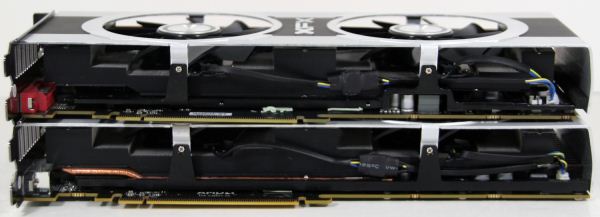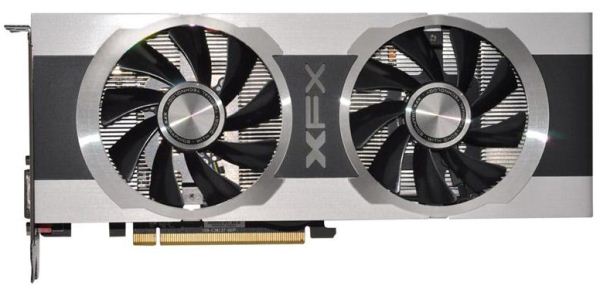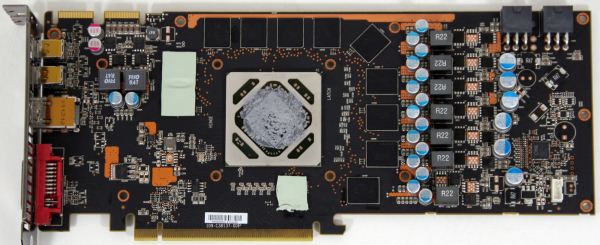AMD Radeon HD 7950 Review Feat. Sapphire & XFX: Sewing Up The High-End Market
by Ryan Smith on January 31, 2012 9:02 AM ESTMeet the XFX R7950 Black Edition Double Dissipation
Our second partner card of the day is XFX’s R7950 Black Edition Double Dissipation. Like the 7970 Black Edition Double Dissipation we reviewed earlier this month, the 7950 BEDD is a factory overclocked card (Black Edition) using XFX’s Double Dissipation cooler.
Starting with the overclock, XFX is shipping the 7950 BEDD with a core clock of 900MHz and a memory clock of 5.5GHz. This represents a 100MHz (12.5%) core clock overclock and 500MHz (10%) memory clock overclock, putting it just shy of the 925MHz core clock the 7970 ships at.
In terms of construction like all of the other 7950 cards launching today XFX is using AMD’s 7950 PCB. This means the PCB measures 10.25” long and features 2 6pin PCIe power sockets towards the rear of the card, while at the front the card uses the AMD standard port configuration of 1 DL-DVI, 1 HDMi, and 2 mini-DisplayPorts. The one notable deviation here from the Sapphire card is that XFX has not included a BIOS selection switch, so the card lacks any kind of ability to easily recover from a bad BIOS flash, and if unlocking proves viable it would not be a good candidate for the process.
Meanwhile cooling is provided by XFX’s Double Dissipation cooler. This is the same heatsink and fan assembly we saw with the 7970 BEDD, which makes this an open air cooler using a pair of fans to push air along an aluminum heatsink running almost the entire length of the card. Because it’s the same assembly, the shrouding for the card sticks out over the end of the PCB, negating the benefit of the shorter 7950 PCB and making the card 10.65” long just like the 7970 BEDD.

Top: 7950 BEDD. Bottom: 7970 BEDD
Do note that while it uses the same fan and heatsink assembly, Double Dissipation does not mean it uses the same vapor chamber assembly to transfer heat from the card. Where the 7970 BEDD used a fairly large vapor chamber, the 7950 BEDD uses a much smaller vapor chamber that only makes contact with roughly half of the heatsink, meaning that heat isn’t being transferred to the extremities of the heatsink nearly as well on the 7950 BEDD. Furthermore the aluminum plate covering the RAM and MOSFETs is poorly sized, leaving parts of the RAM chips (and their thermal pads) exposed. We’ll see how this plays out when we get to our testing, but the 7950 BEDD is clearly not as well built as the 7970 BEDD.
Rounding out the package is the same collection of extras that we saw in the 7970 BEDD. Inside you’ll find the usual driver CD and quick start guide, along with a metal XFX case badge, a mid-length CrossFire bridge, and a passive HDMI to SL-DVI adaptor. All of this is packed in one of XFX’s pleasantly small boxes, which doesn’t use much more space than the card itself.
The MSRP on the 7950 BEDD is $499, $50 over the MSRP for a regular 7950 and making it one of the more expensive 7950s launching today. XFX is offering a base 2 year warranty on the 7950 BEDD, which can be extended to a lifetime warranty by registering the card within 30 days of purchasing it.












259 Comments
View All Comments
chizow - Saturday, February 4, 2012 - link
Well I'm not one to totally dismiss metrics like power consumption, thermals, noise but really those types of considerations are tertiary for anyone looking in this segment, especially when its very clear relative pricing is based on performance and performance only.Performance is primary, secondary considerations would be actual features (API, multi-mon, 3D, compute, etc.) and these fringe considerations like power, noise, heat a distant 3rd for anyone interested in this segment. It is more important for some people, but generally, performance is not the primary consideration for those people. Generally those who shop in this segment look at performance without compromise.
In any case, Nvidia's strategy for their flagship ASICs have always been big die since the G80 and from that they've generally derived their top two desktop SKUs and X2 parts. But on top of that, they also put these ASICs in their highly lucrative professional parts like Tesla and Quadro. This is not unlike Intel's strategy with their highest-end CPUs (Westmere, SB-E) where the highest-end parts are shared between their high-end server and enthusiast desktop platform.
AMD's strategy used to be "small die" after the R600 fiasco, where they would release a much smaller chip and still remain competitive through smaller process node and higher clock speeds with a halo X2 part made easier because of these smaller die sizes. But if you look at the die comparisons over the years, you can clearly see this small die strategy is getting away from them as well, as their chips have grown in size and power consumption through each generation.
There was always internal conflict over this "small die" decision though, but it looks to me like the "big die" folks are back in favor at AMD GPU as they realize they will never be able to beat Nvidia with a smaller die and higher clocks alone and aren't going to fetch a higher asking price based on just good looks and more attractive thermals.
Arnir69 - Saturday, February 4, 2012 - link
I was looking forward to 7950 but the perf jump from my 580 is negligible so I'm going to pass, was expecting more from AMD, loved their 6950 in cfx which was awesome value. If I was still running those there would be even less reason to buy 79xx. I agree with Chizow's point: Nothing new or exciting here, now looking at Kepler to shakeup 2012's high end graphics scene.chizow - Saturday, February 4, 2012 - link
Thanks, I knew there were reasonable minds out there that felt similarly. Reading through the comments there are definitely more who feel the same way, which is assuring, because I really don't want to see a $750 flagship card from Nvidia.It just seems there's a few unreasonable folks out there who just want to ignore the obvious along with mountains of historical data points that tells us what AMD has done here with Tahiti pricing is unprecedented and frankly, quite shocking.
RussianSensation - Saturday, September 8, 2012 - link
"If GK110 beats the 7970 by 20-25% and costs only $500, AMD execs will be jumping out of windows."GK104 $500 ended up losing the performance and price/performance crown to the HD7970 OC on air and on water. Looks like your prediction didn't come true this round.
HaydenOscar - Tuesday, January 31, 2012 - link
"[partner cards]"In the middle of the first page. :)
prime2515103 - Tuesday, January 31, 2012 - link
"On January 20st..."Paragraph one, line two, sentence two.
jjj - Tuesday, January 31, 2012 - link
with the 6970 starting at 300$,this one is a tough sellcasteve - Tuesday, January 31, 2012 - link
looks like a cut/paste error creeped in. :)casteve - Tuesday, January 31, 2012 - link
sapphire pricing in the table needs to be updated, too.Ryan Smith - Tuesday, January 31, 2012 - link
Please reload. It should already be fixed.